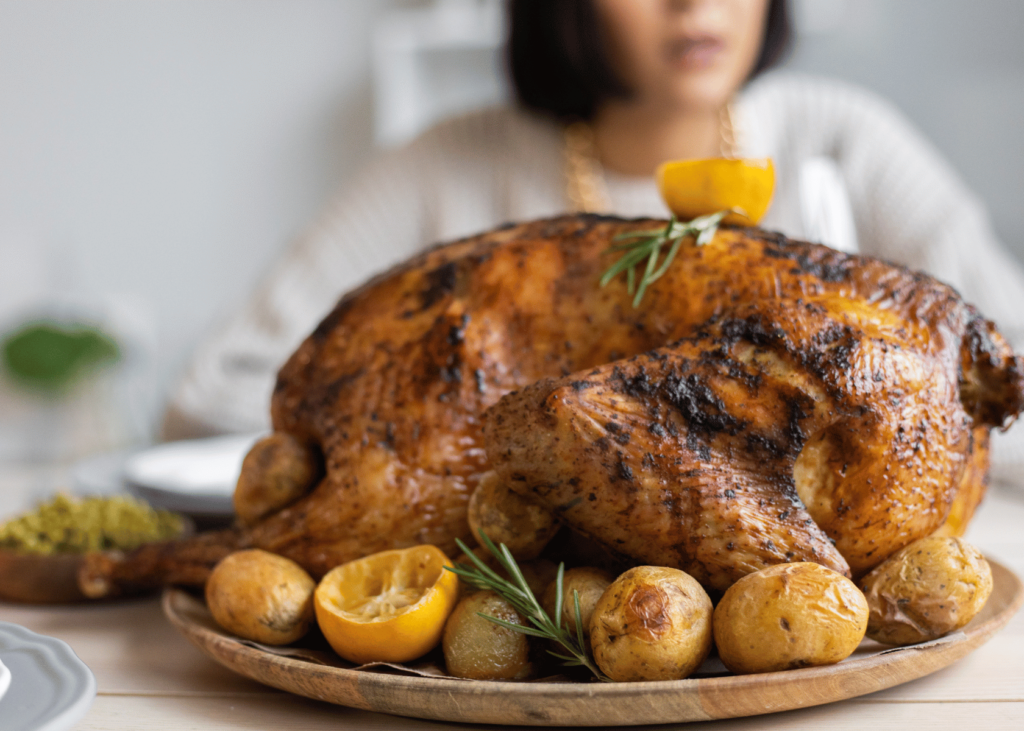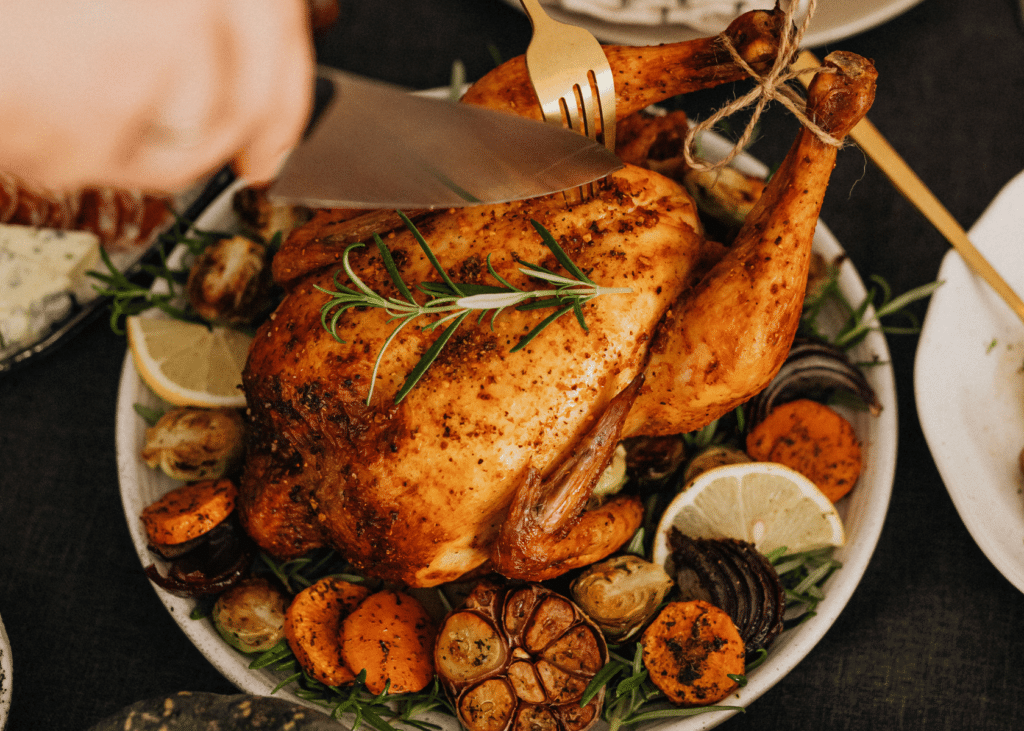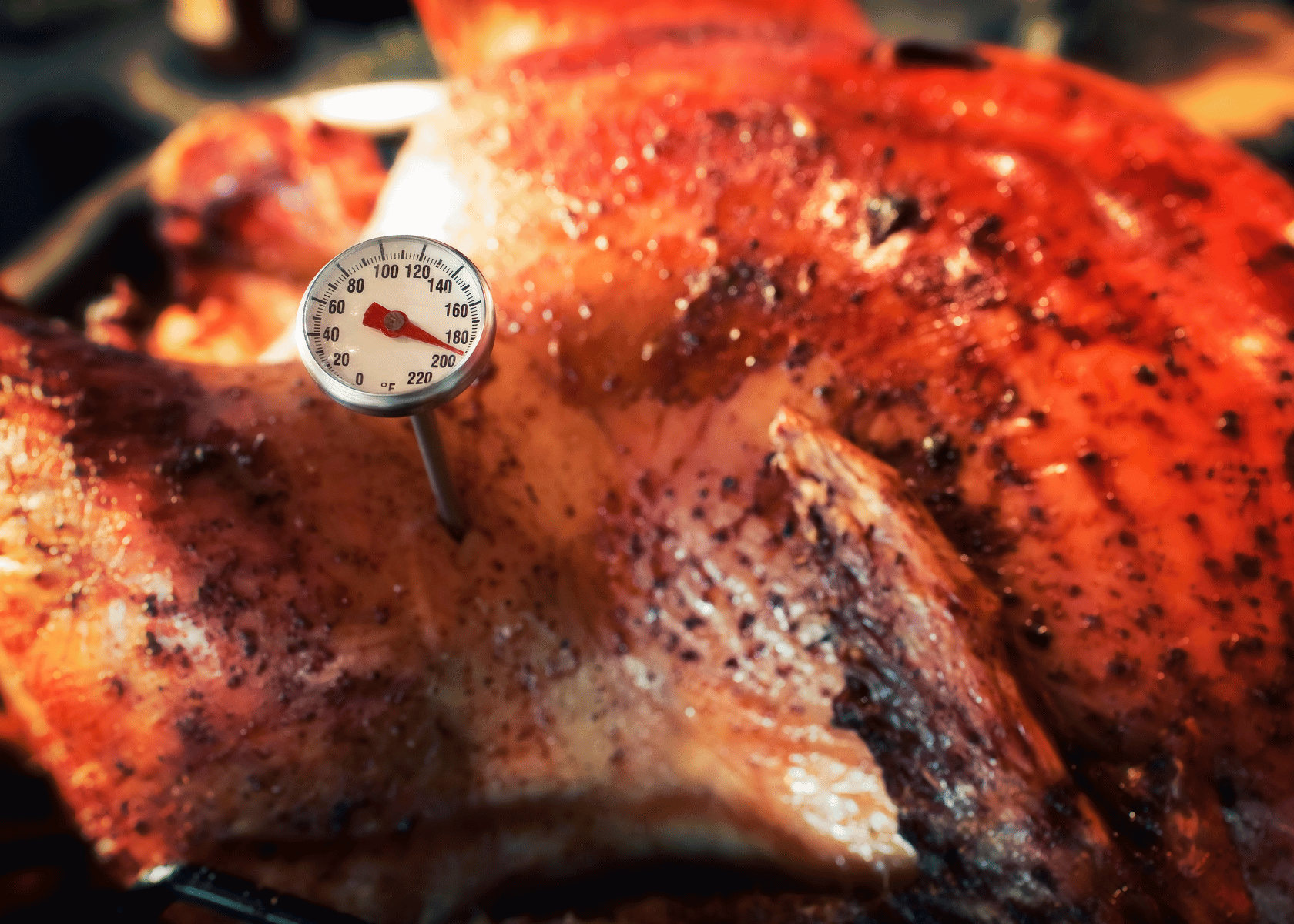Cooking the perfect turkey often boils down to one crucial detail – knowing exactly where to insert a meat thermometer. Believe it or not, placing your meat thermometer correctly can make all the difference between a juicy, golden brown bird and an overcooked dry disappointment.
This article will guide you through precise placement of a meat thermometer for that flawlessly cooked turkey every time. Let’s turn your next turkey feast into a resounding success!
Key Takeaways
- Placing a meat thermometer in the thickest part of the turkey breast and innermost part of the thigh ensures accurate temperature readings for both food safety and achieving perfect doneness.
- Proper technique includes inserting the thermometer horizontally near the neck cavity. It should be avoiding contact with bones, and checking multiple spots for consistency.
- A reliable meat thermometer is essential to ensure that your turkey reaches a safe internal temperature of at least 165°F. This helps in preventing undercooked or overcooked meat.
Importance of Using a Meat Thermometer
Using a meat thermometer is essential for two reasons: ensuring food safety and achieving perfect doneness.
Ensuring food safety
Proper use of a meat thermometer in turkey preparation is crucial for ensuring food safety. Incorrect placement can lead to inaccurate readings. This can potentially cause the poultry to be undercooked and pose a risk for foodborne illness.
The USDA recommends that all parts of the turkey reach an internal temperature of at least 165°F. This will help to kill any harmful bacteria present. Inserting the thermometer tip into the thick part of the thigh without touching bone provides an accurate measure. Similarly, it does placing it into both sides and center of the thickest part of the breast.
Be diligent about these strategies not only guarantees truly delightful dining but also promotes essential health protection for everyone at your table.
Achieving perfect doneness
To achieve perfect doneness when cooking a turkey, using a meat thermometer is essential. The internal temperature of the bird is what determines whether it’s safe to eat and if it has reached the ideal level of tenderness.
By inserting a meat thermometer in the thickest part of the turkey breast, you can accurately monitor its temperature throughout cooking. This ensures that you cook your turkey to perfection – not undercooked or overcooked – resulting in juicy and flavorful meat that your guests will love.
Remember, reaching a safe internal temperature is crucial for food safety as well, so always use a reliable meat thermometer to achieve that perfectly cooked turkey every time.
Where to Insert a Meat Thermometer in a Turkey
To ensure accurate temperature readings, it is important to know where to insert a meat thermometer in a turkey.
Thickest portion of the turkey breast
For an accurate reading of the turkey’s internal temperature, it is crucial to insert the meat thermometer into the thickest part of the turkey breast. This ensures that you are getting an accurate measure of the heat distribution throughout the bird.
By placing the thermometer in this spot, you can gauge whether your turkey has reached a safe internal temperature for consumption and also achieve perfectly cooked meat that is juicy and flavorful.
Remember to avoid touching any bones when inserting the thermometer to prevent false readings.
Innermost portion of the thigh
To ensure that your turkey is cooked perfectly, it’s crucial to insert a meat thermometer in the innermost portion of the thigh. This is because the thigh takes longer to cook than other parts of the bird, and its internal temperature needs to reach a safe reading for consumption.
By placing the thermometer in this spot, you can accurately monitor the doneness of your turkey and avoid undercooking or overcooking it. Remember, make sure that the probe is inserted into the thickest part of the thigh without touching any bones for an accurate temperature reading.
Proper Technique for Inserting the Thermometer

To ensure accurate temperature measurement, insert the thermometer probe horizontally near the neck cavity. However, it’s important to make sure it is in an even layer of meat.
Insert horizontally near the neck cavity
To ensure your turkey is cooked to perfection, it’s essential to insert the meat thermometer in the right spot. One important location is horizontally near the neck cavity. This allows you to track the internal temperature of the breast accurately, which should reach around 165°F for safe consumption.
By placing the probe in this area, you can ensure that you’re getting an accurate reading. In this way, you can be sure that you are cooking your turkey just right. Remember not to touch any bone when inserting the thermometer for a precise measurement every time.
Ensuring the probe is in an even layer of meat
To ensure accurate temperature readings, it is crucial to make sure that the meat thermometer probe is inserted into an even layer of meat. This will help prevent any false readings that could occur if the probe touches bones or other uneven surfaces.
By inserting the thermometer in a consistent and uniform depth, you can be confident in obtaining reliable temperature measurements throughout the cooking process. So remember, take your time when inserting the probe and aim for an even layer of meat for precise results every time.
Tips for Accurate Temperature Measurement
Avoid contact with bone when inserting the meat thermometer into the turkey, and check multiple spots for consistency to ensure an accurate temperature reading.
Avoiding contact with bone
To ensure accurate temperature measurement, it is essential to avoid contact with the bone when inserting a meat thermometer into the turkey. The bone can give off its own heat, which may lead to an inaccurate reading and potentially undercooked or overcooked meat.
When inserting the thermometer probe into the breast, thigh, or inner wing of the turkey, be mindful of avoiding any contact with bones. By placing the thermometer in an even layer of meat without touching bone, you can get a more precise reading of the turkey’s internal temperature.
This will help you achieve that perfectly cooked bird for your Thanksgiving feast without any guesswork involved.
Checking multiple spots for consistency
To ensure accuracy when using a meat thermometer in a turkey, it’s important to check multiple spots for consistency. This means inserting the thermometer probe in different areas of the bird and comparing the readings.
By doing so, you can ensure that the entire turkey has reached its desired internal temperature and is cooked evenly throughout. Remember to avoid touching bones with the thermometer probe as this can give false readings.
Checking multiple spots for consistency will help guarantee a perfectly cooked turkey, giving you confidence in serving a safe and delicious meal to your family and guests.
Frequently Asked Questions

1. Where should I insert a meat thermometer in a turkey?
The best place to insert a meat thermometer in a turkey is the thickest part of the thigh! However, make sure it does not touch bone.
2. How deep should the meat thermometer be inserted into the turkey?
When inserting a meat thermometer into a turkey, it should be inserted about 2 inches into the thickest part of the thigh.
3. Why is it important to use a meat thermometer when cooking a turkey?
Using a meat thermometer is important when cooking a turkey! It ensures that the internal temperature reaches at least 165°F (74°C)! It is necessary to kill any harmful bacteria and ensure that the turkey cooks safely!
4. Can I rely on visual cues alone to determine if my turkey is fully cooked?
While visual cues such as golden brown skin can provide an indication of doneness. It’s best to rely on using a meat thermometer for accuracy. This ensures that both white and dark meats reach their appropriate safe temperatures, resulting in juicy and properly cooked turkey.
Conclusion
In conclusion, knowing where to insert a meat thermometer in a turkey is crucial for both food safety and achieving the perfect doneness. By placing the thermometer probe in the thickest portion of the turkey breast and innermost part of the thigh, you can ensure an accurate temperature reading.
Remember to use proper technique, avoiding contact with bone, and checking multiple spots for consistency. With these tips, you’ll be able to cook your turkey to perfection every time!

